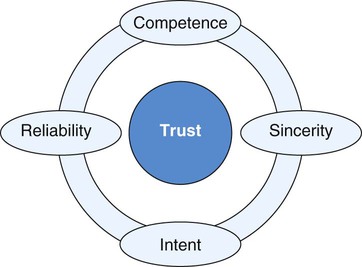Chapter 4 In baseball, no matter how well you play defense, you cannot score runs while you are in the field. Listening works the same way. You can only learn by listening, no matter how good of a speaker you are. See Chapter 7 for strategies on becoming a good listener. So how do you demonstrate respect? First, remember that small efforts make a big difference: use names, ask about family or experiences, offer to help, pay sincere compliments. When you demonstrate this kind of interest and acceptance, people perceive you as accepting, reasonable, and intelligent. They will know that you respect them. Figure 4-1 shows a health professional expressing genuine interest in her patients. This interaction displays the trust that you should work to achieve with every patient. In an atmosphere of trust, people share information and tolerate mistakes because they acknowledge that mistakes are necessary steps on the path to excellence. People are loyal and support one another. The environment fosters creativity, innovation, and workflow improvements. Co-workers regularly demonstrate a high degree of productivity and good morale. Figure 4-2 shows important aspects of trust. In contrast, a distrustful environment is divisive. Morale suffers, turnover increases, and patients leave after acknowledging this dynamic. Table 4-1 compares characteristics of trusting organizations and organizations where trust is lacking. TABLE 4-1 Characteristics of Organizations That Trust and Those That Don’t Trust
Being Easy to Deal With
 Know how important trust is to your success in the health professions.
Know how important trust is to your success in the health professions.
 Have a strategy to earn and keep trust in your new job.
Have a strategy to earn and keep trust in your new job.
 Understand why empathy is a necessary trait in the health professions.
Understand why empathy is a necessary trait in the health professions.
 Explain the neurologic basis for empathy.
Explain the neurologic basis for empathy.
Learning Objectives for Building Trust
 Understand how people learn to trust others.
Understand how people learn to trust others.
 Know how to build trust in yourself among your co-workers.
Know how to build trust in yourself among your co-workers.
 State the benefits of a trusting organization.
State the benefits of a trusting organization.
 Consider the advantages of forgiveness.
Consider the advantages of forgiveness.
The Building Blocks of Trust
Listening
Cultivating Respect
Organizational Trust

Trusting Organizations
Organizations Without Trust
Information is shared
Information is withheld
People support one another
People look out for themselves
Teams
Cliques
Communication
Gossip
Autonomy
Micromanagement
Innovation
Bureaucracy
Fun place to work
Low morale
Longevity, experience
Turnover
Satisfied customers
Customer turnover


















